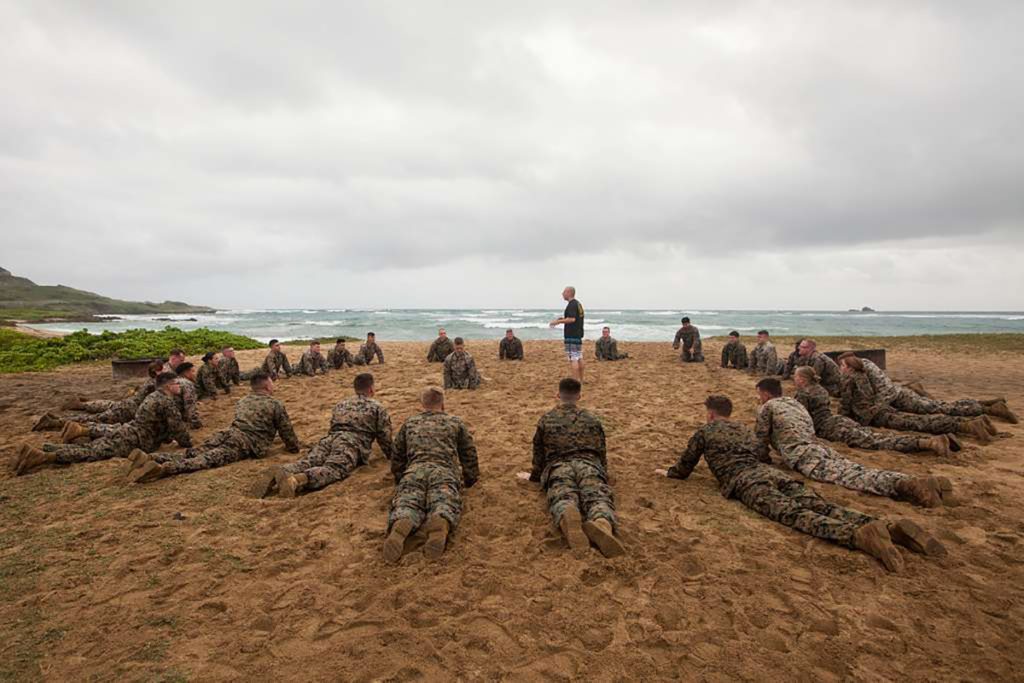
Rucking: How to Do Weighted Backpack Training Like a Marine
You don’t have to be a US Marine to train like one. Rucking is gaining popularity as a low-impact, high-intensity workout. The added weight improves cardiovascular endurance, builds strength and muscular endurance, and enhances functional fitness.
This article will get you started with Marine Corps-style weighted backpack training. Learn about the benefits, essential gear, and techniques for safe and effective rucking
Benefits of Weighted Backpack Training
There are reasons why Marines train for loaded marches. Gains in functional stength and cardiovascular endurance are at the top of the list.
Rucking with a weighted backpack is an excellent choice for anyone looking to improve their heart health and stamina. It can also increase muscular strength by engaging numerous muscle groups throughout the body. Additionally, rucking helps enhance functional fitness and carrying capacity, as it simulates real-life situations that require lifting and carrying objects.
Another advantage of weighted backpack training is weight loss. The added resistance intensifies the workout, leading to a higher calorie expenditure. Furthermore, rucking is a low-impact exercise suitable for individuals of various fitness levels. Unlike high-impact exercises like running or jumping, rucking minimizes joint stress. So it’s accessible to people with joint issues or those who prefer low-impact workouts.
Overall, incorporating weighted backpack training into a fitness routine can lead to significant improvements in cardiovascular and muscular endurance, functional fitness, and weight management.

Getting Started With Rucking
Rucking might seem daunting, but a simple approach is all that’s needed to win.
Start by selecting the appropriate backpack or rucksack that suits your needs. Comfort and durability are the top two characteristics of a good sack. It should support the desired weights without causing discomfort or injury. Rucksacks come in different sizes depending on your needs. USMC bags are the best, but most backpacks will due in a pinch.
Make your march comfortable by selecting flat ruckweights or weightplates. Avoid objects with edges that might cause discomfort. Take the time to ensure a proper fit and weight distribution too. Padding is also recommended. Finally, adjust your rucksack straps to fit your body securely. Use compression straps to secure the weight and avoid shifting.
Hydration is crucial too. Choose a system that is compatible with your backpack and easy to access while rucking. If that’s not possible, flasks and canteens work too. It also pays to prepare for rain, sun, or cold temperatures by including appropriate clothing, sunscreen, or extra layers in your pack. And if you’re putting in high mileage or are in wilderness, consider packing first aid.
Gear in hand, you’re ready to yomp. Start light and gradually increase the intensity over time. This approach helps build endurance and strength while minimizing injury risk. It’s not always easy, but avoid pushing too hard, too quickly. Gradually add weight and increase the distance of your marches.
Proper Rucking Technique and Form
There is some technique involved to get the most gains without injury.
First, maintain an upright posture and engage your core muscles. This helps distribute the weight evenly and reduces strain on your back.
Next, walk with a natural stride and maintain a consistent pace. Avoid overstriding or taking excessively long steps, as this can lead to discomfort or imbalance. Find a pace that feels comfortable and allows you to maintain good form.
It’s important to avoid excessive swinging of the backpack. Keep it close to your body and minimize unnecessary movements that can throw off your balance. Compression straps helps with this.
When walking on rough terrain, pay attention to your foot strike. Take shorter steps to maintain stability and prevent tripping or stumbling. Adjust your stride and foot placement to accommodate the uneven surface.

Incorporating Weighted Backpack Training into a Fitness Routine
Incorporating rucksack training into your fitness routine can bring significant benefits. Here’s how to do it effectively.
Begin by determining the frequency and duration of your ruck workouts. Start with one to three sessions per week and gradually increase as you build endurance. And aim for 30 to 60 minutes per session, depending on your fitness level and goals.
Design a progressive training plan that gradually increases the weight and distance of your rucking.
To enhance your overall fitness, combine rucking with other forms of exercise, such as strength training or cardio. For an added challenge, incorporate interval training or inclines during your rucking sessions. This can be periods of faster-paced walking or jogging and slower recovery periods. Additionally, find hilly terrains or inclines to increase the intensity and engage more muscle groups.
Lastly, track your progress and set specific goals. Monitor your distances, weights, and times to see improvements over time. Set realistic and achievable goals to keep yourself motivated and continue progressing in your rucking journey.
Safety Considerations and Injury Prevention
Safety is of utmost importance when engaging in weighted backpack training.
First and foremost, listen attentively to your body, be mindful of any signs of injury and adjust your workout accordingly. Prioritize a thorough warm-up routine, including dynamic stretching exercises, to adequately prepare your muscles for the demands of rucking.
Equally essential is selecting appropriate footwear. You want comfort and support to minimize the risk of foot and ankle injuries. Moreover, pay close attention to your body mechanics and form. Maintain a straight back, engage your core, and avoiding excessive leaning or twisting.
Again, ensure a gradual progression in the amount of weight you carry, avoiding sudden increases that could overwhelm your body. By adhering to these safety considerations, you can confidently partake in rucking while mitigating the risks associated with this rigorous military exercise.

Tips for Rucking in Various Environments
When it comes to rucking, adapting to different environments is key. Here are some tips for rucking in various settings to enhance your experience.
When rucking on pavement and in urban settings, be mindful of the impact on your joints. Consider using shock-absorbing insoles or choosing routes with softer surfaces like grass or dirt paths. Additionally, stay alert and aware of traffic and pedestrians for your safety.
Rucking on trails and uneven terrain requires extra attention to your footing. Take shorter steps and maintain a slower pace to navigate obstacles effectively. Use trekking poles for added stability and to distribute the weight more evenly.
Weather conditions can significantly impact your rucking experience. When rucking in hot weather, hydrate adequately and wear breathable clothing. In cold weather, layer appropriately to stay warm and protect yourself from frostbite. Don’t forget sunscreen in sunny conditions and be prepared for rain by using waterproof gear.
Lastly, consider the time of day when rucking. Early mornings and late afternoons are generally cooler and less crowded. However, ensure you have proper visibility if rucking during low light conditions, such as dawn or dusk. Use reflective gear or carry a flashlight to make yourself visible to others.
By following these tips, you can adapt to different environments and make the most of your rucking experience, regardless of the setting, weather, or time of day.

Recovery and Injury Management
Proper recovery will keep you on the battlefield. Follow these general guidelines to optimize your recovery and effectively manage any potential injuries.
After rucking, dedicate time to cool down and stretch your muscles. This reduces soreness and promotes flexibility. Focus on stretching your calves, hamstrings, and hips.
A foam rolling or self-massage techniques also aid in recovery, alleviating muscle tension, improving blood flow, and aiding muscle recovery. Target areas of tightness or discomfort with the roller or use a lacrosse ball for more targeted pressure points.
Take preventitive measures to manage blisters or chafing. Wear moisture-wicking socks and well-fitted footwear to minimize friction. Apply lubricants or bandages to areas prone to blisters or chafing. If blisters do occur, keep them clean and protected to prevent infection.
If you experience persistent pain or have concerns about an injury, seek professional help. Consult a healthcare professional, such as a sports medicine specialist or physical therapist, who can provide a proper diagnosis and guide you through appropriate treatment and rehabilitation.
Rucking Like a Marine
Armed with knowledge of how to ruck like a Marine, it’s time to take action. Strap on your weighted pack, hit the road, and experience the transformative effects of this versatile exercise.
If you’re in need of gear, don’t forget to check out our selection of top-quality ruck bags, PT gear, and other useful rucking supplies to enhance your experience.
We encourage you to share your rucking stories in the comments below, as your experiences can serve as motivation and inspiration for fellow ruckers. Together, let’s forge ahead on our fitness journeys and unlock our full potential through the power of rucking.

